|
|
 [Image: "Moravian Mount" from New Local Zlín by Margaret Bursa]. [Image: "Moravian Mount" from New Local Zlín by Margaret Bursa].In a recent post I included an image from Margaret Bursa's project New Local NY, which she produced while a student at the Bartlett School of Architecture. Bursa's tutors for that project were Mark Smout and Laura Allen, of Smout Allen; and I should right away that I'm consistently amazed at the quality of work coming out of Smout Allen's studios. I thought, then, that I should take the occasion to share more images from Bursa's projects. You can check out her website here. 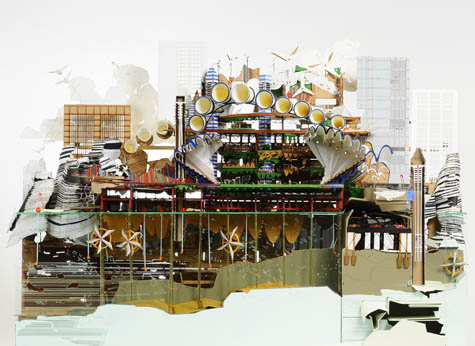 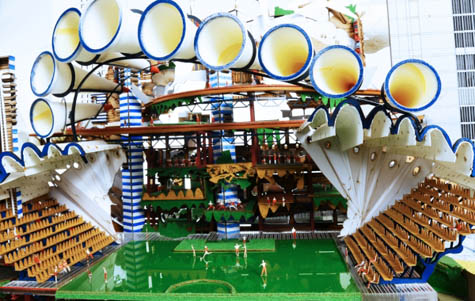 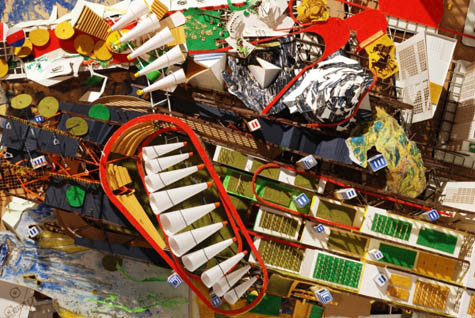 [Images: From New Local NY by Margaret Bursa].New Local NY [Images: From New Local NY by Margaret Bursa].New Local NY features "a ‘landscape of movement’," Bursa writes. It "takes the form of a condensed urban playground on the west side of Manhattan, overhanging onto the River Hudson," and it was at least partially inspired "by the ongoing relocation of immigrants and cultures to America, in particular Sokol, a Czech mass-exercise movement, promoting togetherness, flocking, fresh air and cultural pride." The result is an intensely colorful, wind-powered megastructure, sitting comfortably astride the worlds of home craft and experimental architecture.  [Image: From New Local NY by Margaret Bursa]. [Image: From New Local NY by Margaret Bursa].Here are some amazing sectional sketches: 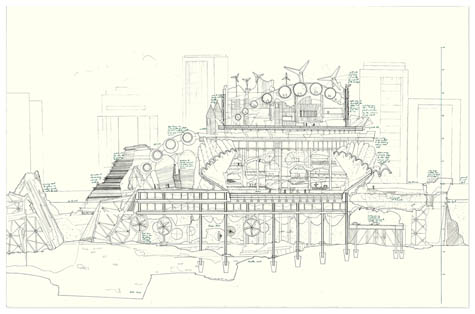 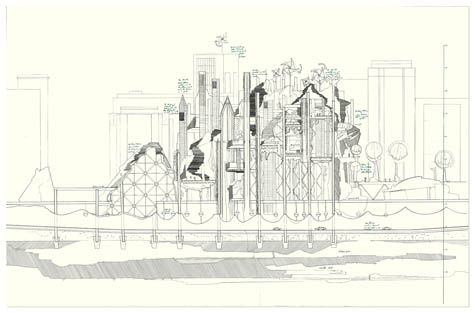 [Images: From New Local NY by Margaret Bursa; larger version one and two]. [Images: From New Local NY by Margaret Bursa; larger version one and two].Then there is New Local Zlín, an earlier companion piece to New Local NY. Zlín, Bursa explains, is the fading capital of the Bata shoe-making empire: The Czech town of Zlín is the site of a social, industrial and architectural experiment begun by Tomas Bata in 1894. However, his shoe-making factories that were once the town’s driving force no longer operate and so the social and commercial structure of the town and its suburbs are in decline. Responding to the New Local Manifesto, a layer of facilities is laid over and interwoven into the residential neighborhoods where seven housing typologies are afforded dual functions of work and domestic life such the House of Drink, where both production and consumption are combined. The images, again, are drenched in color and extraordinarily detailed. 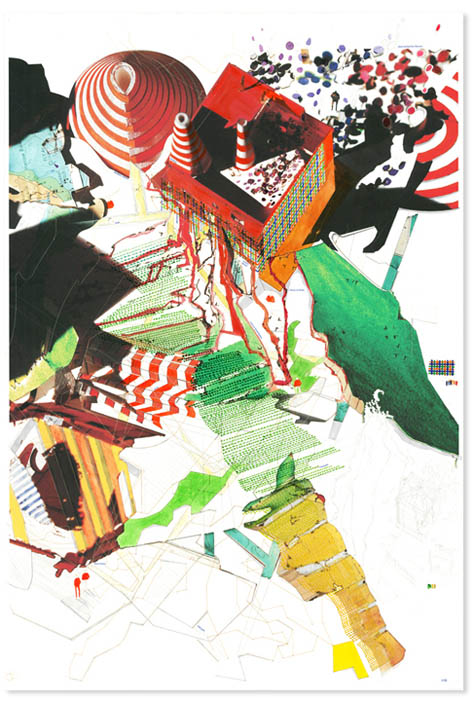 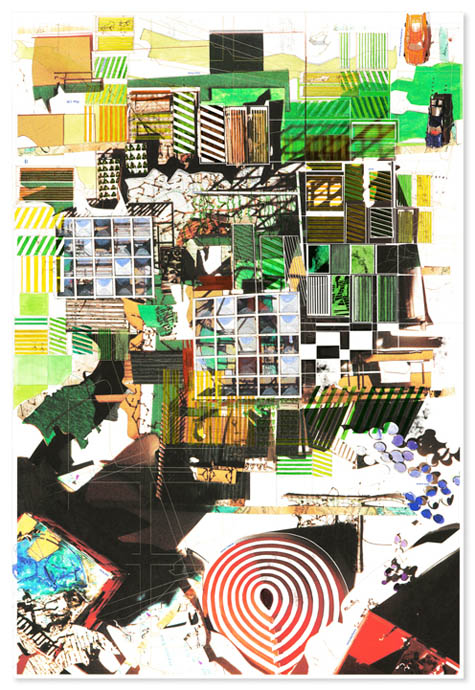  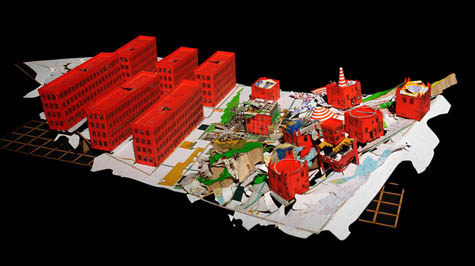 [Images: "House of Drink," "Greenhouse," and town plan from New Local Zlín by Margaret Bursa]. [Images: "House of Drink," "Greenhouse," and town plan from New Local Zlín by Margaret Bursa].The next project is a kind of tube-diorama: you look into the miniature landscape and see autumn trees, a ruined Greek temple, and a many-windowed architectural section standing in silhouette. The project seems to come with the implication that, when you look inside a telescope, perhaps it's possible that you might simply be seeing a world inside the telescope—that is, an optical device that, instead of revealing new worlds from afar, actually contains local worlds within it. 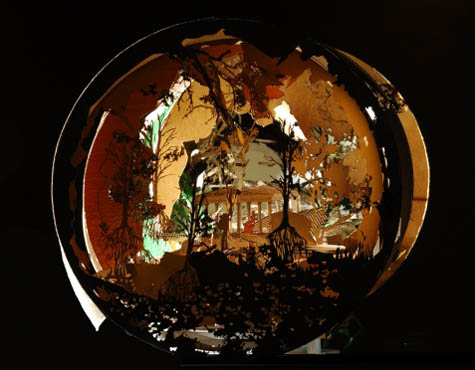 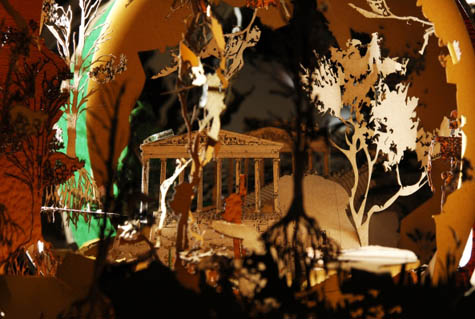 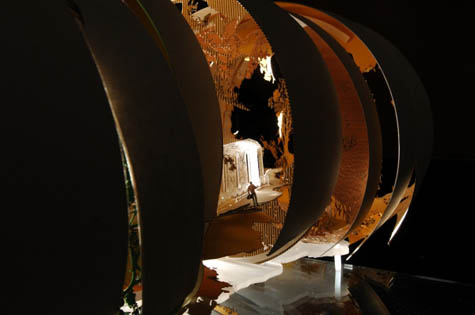 [Image: From Layered Landscapes by Margaret Bursa]. [Image: From Layered Landscapes by Margaret Bursa].Called Layered Landscapes, the project is a "compositional map," Bursa writes, and it comes complete with hardcover book and poster. 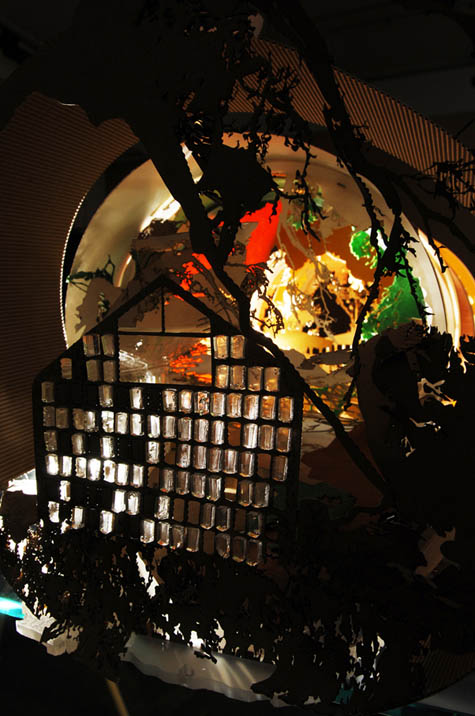  [Images: From Layered Landscapes by Margaret Bursa]. [Images: From Layered Landscapes by Margaret Bursa].Finally, I have a weird affinity for sketches of archways, and so I'd be remiss if I didn't include this short series of brick studies—called, unsurprisingly, Brickscape. 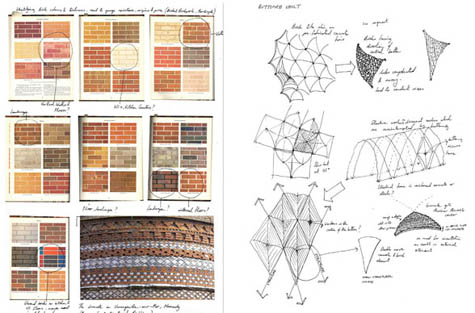  [Images: From Brickscape by Margaret Bursa]. [Images: From Brickscape by Margaret Bursa].In any case, there's some great work in there. Check out Bursa's site for a bit more.
 [Image: Michael Light, Bingham Pit photograph mounted and on display]. [Image: Michael Light, Bingham Pit photograph mounted and on display].A beautiful new book of photographs by Guggenheim Fellow Michael Light has been released. Called Michael Light: Bingham Mine/Garfield Stack, and released by Radius Books, it includes an essay by "experimental geographer" Trevor Paglen.  [Image: Two photos from Michael Light: Bingham Mine/Garfield Stack]. [Image: Two photos from Michael Light: Bingham Mine/Garfield Stack].Light, well known for, among other things, his aerial photographs of the American west, "pursuing themes of mapping, vertigo, human impact on the land, and various aspects of geologic time and the sublime," as Radius Books describes it, has put together a collection of 22 images from his surveys of the Bingham Pit and the Garfield smelter stack. The sheer scale of each site—one a void excavated into the surface of the earth, the other one of the tallest structures in the United States—is mind-blowing: Located at 8,000 feet in the Oquirrh Mountains—20 miles southwest of Salt Lake City—the Bingham Canyon copper mine is the largest man-made excavation on the planet. Its hole reaches more than half a mile deep and its rim is nearly three miles in width. It has produced more copper than any mine in history.  [Image: Michael Light, "Garfield Stack, Oquirrh Mountains and Ancient Beach of Great Salt Lake" (2006)]. [Image: Michael Light, "Garfield Stack, Oquirrh Mountains and Ancient Beach of Great Salt Lake" (2006)].Meanwhile: The mine’s Garfield smelter stack, situated at the edge of the Great Salt Lake about 10 miles away, is the tallest free-standing structure west of the Mississippi River, and is only 35 feet shorter than the Empire State Building. In a nearly 9-page interview with Afterimage, Light comments: I work with big subjects and grand issues, and I am fascinated about that point where humans begin to become inconsequential and realize their smallness in relation to the vastness that is out there. In my archival work I also enjoy inserting a certain kind of revisionist politics into big iconic subjects that are owned by the world, where I can tell a story through my particular prism, in a way that hopefully offers a fresh perspective. This is part of his ongoing interest in taking apart "the fundamental building blocks of landscape perception and representation." The book is available through Radius.
" Who would want to be an architect?" the Times asks. In answering that question, the article focuses more or less entirely on London's Bartlett School of Architecture—whose students have been producing some amazing work lately, work that I have often posted about here on BLDGBLOG. Here, here, here, and here, for instance. But, the article claims, "Leave the future to Bartlett students and we’ll all be living in car-crash spaces that occasionally come into focus as giant mechanised spindly crustacea." 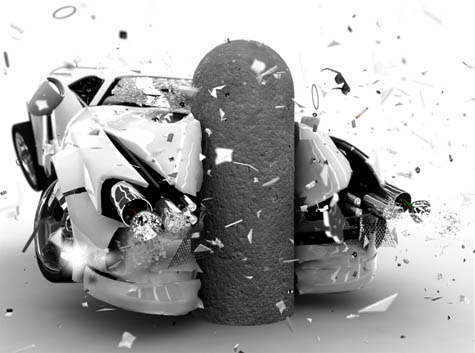 [Image: "Oops" by C. Loopus]. [Image: "Oops" by C. Loopus].Reading such things easily prompts the familiar zing of schadenfreude—but it also seems totally inaccurate. If only it were as cut-and-dried as mistaking student work for what someone will produce professionally later; if only it were as easy as extrapolating from someone's earliest university sketchbooks to see how they'll someday end up. I'm reminded here of Lebbeus Woods's recent short essay on the work of Rem Koolhaas: there was " another Rem," Lebbeus writes. Looking back at one of Rem's early projects—an unsuccessful bid for the Parc de la Villette in Paris—Lebbeus suggests: This project reminds us that there was once a Rem Koolhaas quite different from the corporate starchitect we see today. His work in the 70s and early 80s was radical and innovative, but did not get built. Often he didn’t seem to care—it was the ideas that mattered. Over on his own blog, Quang Truong puts it more simply: "Young Koolhaas was just so punk." (Of course, parenthetically, Truong's formulation opens up a whole series of possible readings through which we could interpret Rem's ongoing career moves; we could say, for instance, that Rem is still "punk," to use that term deliberately, but his decisions to work for clients like the Chinese government are just him giving the finger to you. That is, if punk is a universal form of energetic rebellion, then don't assume that every punk will remain forever on your side).  [Image: From Rem Koolhaas's unbuilt proposal for the Parc de la Villette in Paris, via Lebbeus Woods]. [Image: From Rem Koolhaas's unbuilt proposal for the Parc de la Villette in Paris, via Lebbeus Woods].In any case, my point in citing Lebbeus's essay in this context is to agree with the Times that student work can often stand on the absolute fringes of incomprehensibility, charged with the energy of poetry, myth, or confrontational politics, even verging on functional uselessness—but it's also an ongoing joke at nearly every architecture crit I've been to over the past few years that, upon surviving their final day of project criticism, those students "can now get back to designing minimalist boxes." In other words, there simply is not the assumption in these studios that now you are prepared only for the construction of rhizomes and biomorphopedic multi-agent typology swarms. There is obviously a problem if that is all you have been taught to do; but it's not one or the other. Being taught how to make short films about architecture—more on this, below—doesn't mean you can't simultaneously be taught how to renovate a kitchen or how to market yourself to new clients. The fact of the matter, anyway, is that very few clients today will actually pay to construct "car-crash spaces that occasionally come into focus as giant mechanised spindly crustacea." If architecture school is the only time and place in which you can have the freedom to explore that sort of thing, then I don't see any reason why you should be told not to do so. Again, if that's all your architecture school offers you, leaving you alone to sort out the business of client management as you go, then of course your educational track needs reconsidering. However, much of the Times's criticism seems predicated on the assumption that, if architecture is a vocational trade, similar to plumbing, then it cannot simultaneously be an expressive art, akin to film, painting, or literature. But, of course, it is both. In fact, the controversy more or less instantly disappears: architecture is the imaginative production of future worlds even as it is the act of building houses for the urban poor or the obtaining of technical skills necessary for rationally subdividing office floorplates. 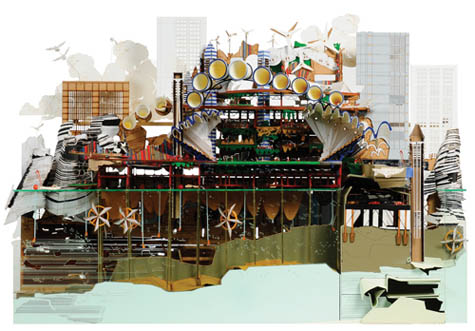 [Image: From a project by Margaret Bursa for the Bartlett's Unit 11, taught by Smout Allen]. [Image: From a project by Margaret Bursa for the Bartlett's Unit 11, taught by Smout Allen].Having said all this, the Times article ends up being a formulaic list of reasons why such-and-such an industry is doomed to fail—too many people want to pursue it, we read, not enough people want to fund it, and hardly anyone understands anymore what made it so popular in the first place. But replace the word "architecture" with "writing," and "Bartlett School of Architecture" with "Iowa Writers Workshop"—or use "music" and "Mills College"—and you'd get a nearly identical article. There are some very real questions to ask about the nature of architectural education today—and, when it comes to things like how architects write, I am probably in agreement with the author of the Times article (and with many of the students quoted in the piece)—but holding up the overall profitability of the industry, and the likely financial success of its individual practitioners, as the only criteria by which we should judge an architecture school seems absurd to me. I'll end this simply by citing some provocative statements made in the article's comments thread— provocative not because I agree with them but because they're well-positioned to spark debate. I'll quote these here, unedited, and let people discuss this for themselves. —The Bartlett "seem to want to be an architecture school and a school of alternate visual media culture at the same time. More often than not these agendas work against each other... They should make a choice and be clear about it. Are you training students to be architects or something else that has to do with architecture? What should a student expect to learn when they finish school? What are you being prepared for. If bartlett graduates go on to become film-makers, and video game designers, and such, maybe its a good idea to say it is not an architecture school and say it is a school of visual media. Then you will attract students with that goal in mind."
—From the same commenter: "Consider, if a school opens up and starts teaching alternative medicine (acupuncture, aromatherapy, Atkins diet, chiropractic medicine, herbalism, breathing meditation, yoga,etc), gives its graduates medical degrees and sent them off to hospitals and emergency rooms to perform surgery, a lot of people would have a problem with that. This is, in effect, what the architectural profession is doing when it allows schools like the Bartlett to give architecture degrees."
—"architectural education is still a leftover of that idea of the businessman/artiste producing unusual shapes for art critics"
—"The profession does not work. It’s economically non viable. Our work is pure iteration. Far too time consuming, and as a result, it’s impossible to charge anyone for the work we have actually done." And on we go... (Spotted via @brandavenue and @ArchitectureMNP).
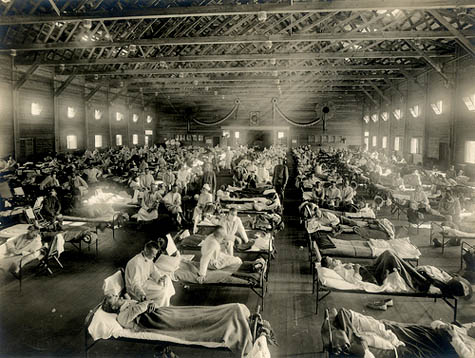 [Image: An emergency hospital ward in Kansas during the 1918 flu]. [Image: An emergency hospital ward in Kansas during the 1918 flu].Dr. Georges Benjamin is executive director of the American Public Health Association (APHA) and former Secretary of Maryland's Department of Health and Mental Hygiene; there his responsibilities included updating the state’s quarantine laws in response to the threat of bio-terrorism. Dr. Benjamin is publisher of both the American Journal of Public Health and The Nation's Health. He is also co-editor, with Laura B. Sivitz and Kathleen Stratton, of the 2005 report Quarantine Stations at Ports of Entry: Protecting the Public's Health. That report consists of more than 300 pages of policy guidelines for how the United States can operate, maintain, and even expand its network of national quarantine stations. The very idea of a national quarantine policy, let alone phrases like the international " Quarantine System," can inspire, at the extreme, all manner of conspiracy-laden theories—including the specter of fully militarized, FEMA-administered concentration camps on U.S. soil. In reality, however, "today's quarantine stations are not stations per se, but rather small groups of individuals located at major U.S. airports. Their core mission remains similar to that of old: mitigate the risks to residents of the United States posed by infectious diseases of public health significance originating abroad." A jurisdictional map of CDC quarantine stations is available online, complete with informational PDFs ready for download. 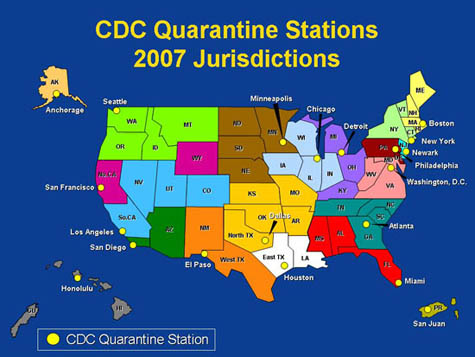 [Image: Map of the CDC's U.S. quarantine stations]. [Image: Map of the CDC's U.S. quarantine stations].As part of our ongoing series of quarantine-themed interviews, Nicola Twilley of Edible Geography and I spoke to Dr. Benjamin about the APHA’s policy recommendations for pandemic flu quarantine, about the role of eminent domain in the medically-motivated seizure of private property, and about the architectural challenge of designing dual-use facilities for public emergencies. • • •Edible Geography: I was interested to read the American Public Health Association’s flu policy recommendations from 2007—in particular, to see the APHA’s emphasis on mental health support for people held in quarantine. What led to that being included in your official guidelines? Dr. Georges Benjamin: If people are going to be confined for some time within a facility, then you want to make sure that you’re identifying those people who are already being treated for mental health issues. You want to make sure they’re getting their therapy and their medications, and you want to deal with any issue that might occur when someone has to stay alone under that level of stress. Remember that someone who is quarantined is different from someone who is isolated. Quarantined people aren’t sick; they’re people who may get sick. They’re people who have been exposed to a disease but who are not physically ill. In many cases of voluntary quarantine, people are being asked to stay at home by themselves, or to stay self-isolated, and we need to make sure that someone is paying attention to them. We want to identify people who are not able to handle being by themselves or being in a relatively confined space—even if it’s inside their own home. We were also concerned about making sure people have the basic needs of life: food, water, access to medical care, and access to social services. You want to make sure that you’ve addressed whatever those needs might be. All of these things were part of our package for people who might be quarantined. BLDGBLOG: Who were the specific constituencies that called for those guidelines, and did anyone try to push you in another direction? Dr. Benjamin: These guidelines come from our members. A lot of these discussions started way back when we were talking about smallpox, rather than pandemic influenza. We were thinking seriously about the idea of having people stay at home and be isolated, if they’re ill, or quarantined should there be a terrorist attack. No one actually has access to smallpox now, but we were going out and vaccinating people against a potential terrorist threat, anyway. So we started having these discussions around the idea of whether or not you really needed to reinstitute large-scale—primarily voluntary—quarantine. In addition, we were talking about the risk of a pandemic. Then, as you know, Hurricane Katrina hit New Orleans. You had people there who, by virtue of the fact that they ended up in the Superdome, did not have all of the things they needed. Certainly a lot of that stuff had been planned for, but it hadn’t been done as robustly as it needed to have been—and, obviously, they had more people in there than they could take care of. Our thinking, based on that experience in New Orleans, was: in an emergency situation, how do you make sure that people have what they need? And, quite frequently, the mental health needs of people are something that matters in every kind of large-scale public health emergency—whether that’s a tornado, a hurricane, the flu, or an event where large numbers of people have died. It’s one of those things that people don’t really think about ahead of time, unless you remind them to think about it. Our recommendations don’t just apply, by the way, to the people who are confined; there are huge stresses on the people who are managing those events. The EMTs, the paramedics, and the public health personnel who are all actually managing things can be really challenged—and you have to pay attention to them, too. 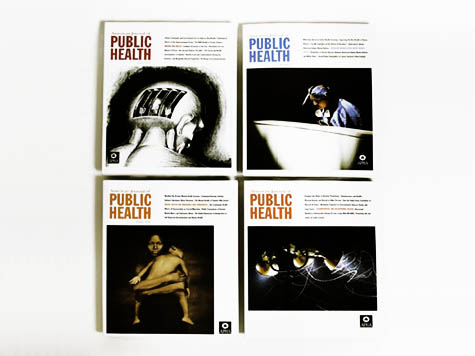 [Image: Sample covers of the American Journal of Public Health; design by Kropf Design].BLDGBLOG [Image: Sample covers of the American Journal of Public Health; design by Kropf Design].BLDGBLOG: The APHA has also written about who exactly should have the authority to make decisions about who goes into quarantine and why. Can you talk us through your policy on that issue? Dr. Benjamin: First of all, we try to guide by the least restrictive policy possible—and, to the extent that someone can be voluntarily in quarantine, that’s our first principle. Voluntary quarantine and the least restrictive quarantine possible is what we think is the most important way to start. Simply giving people the facts about a disease process and keeping them well-educated and well-informed long before you’re going to need to take any action is the best policy. We, as an association, along with our colleagues in the federal agencies, have been trying to talk to the public about what the risks are for various diseases. How do you catch a disease—and how do you not catch it? How you protect yourself? How do you protect your loved ones? Usually, armed with this information, most people will follow the basic recommendations. However, to the extent that you have to have compulsory quarantine—because you have someone who is continuing to put people at risk—then that is imposed, in the United States, by public health authorities. They have powers, mostly at the state and local level: those powers give them the authority to incentivize people not to put others—or themselves—at risk. In some cases, they can do that by having the police authorities act; in other cases, they have to go to court first. It depends on the individual jurisdiction. In most cases, federal authorities’ powers end at the borders of the nation and then at the borders of each state. They can deal with issues across state lines, in some cases, and, of course, at our national borders and at ports of entry; but most of these quarantine authorities rest at the state and local health officer level. BLDGBLOG: Has any of that legislation been revised in light of SARS, H1N1, or even the anthrax attacks? Dr. Benjamin: There has been a national effort to modernize our public health laws. A lot of them were written years and years ago. For instance, I was a state health official in Maryland from 1995 to 1999, and I was the secretary of health in Maryland from 1999 to 2002. During that time we began a process, which we finished when I was secretary, to update and modernize our laws. We had started talking about it before 9/11, but after 9/11 and the anthrax attacks , we realized that biological terrorism was a significant risk, and we really worked to strengthen the public health laws. To give you an example of the kinds of changes and updates we made: we worked to put in some additional patient protections. The law at that time gave the health secretary enormous police powers to hold and to quarantine individuals—but there were no rights or rules for those individuals, or regulations about what they needed to receive while they were in confinement. The assumption was, of course, that they would get reasonable support and care—but we felt it was very important to guarantee that. So we worked with several members of our advocacy community to strengthen the authority that the health officer had, and to make the authorities that I had at the time, as secretary of health, much clearer. But, on the same token, we were writing in protections. We guaranteed people due process. We guaranteed that, if we had to forcibly confine someone, then they would get medical care, social services, and social supports that they actually need. We put that in writing. Other states around the nation have begun doing the same thing. There have been some public health law centers set up through various foundations, and they have also been working very hard to strengthen the various laws. There was a model public health law—I think it was produced with a grant from the Centers for Disease Control and several of the public health groups working with them. That law was then shared with all of the states and their elected officials, and it was used as a template through which states could look at their own laws and see how they matched up to the model. Some states simply took the model and implemented it, exactly as it was written; some took pieces of it out; others took it and said, no, compared to the law we currently have, ours is better and we like ours. Either way, it served as a useful catalyst for people to begin looking at their own public health laws—not only in terms of the authorities that the public health officer had around isolation and quarantine, but also about reportable diseases, which diseases ought to be reported, and how, and who should do the reporting. There were also things that we added around patient protections, citizen protections, and due process. And there were sections that meant to clarify existing law, based on case law in the state, or nationally. That work has been going on since late 2001, and it continues to this day in a variety of formats. 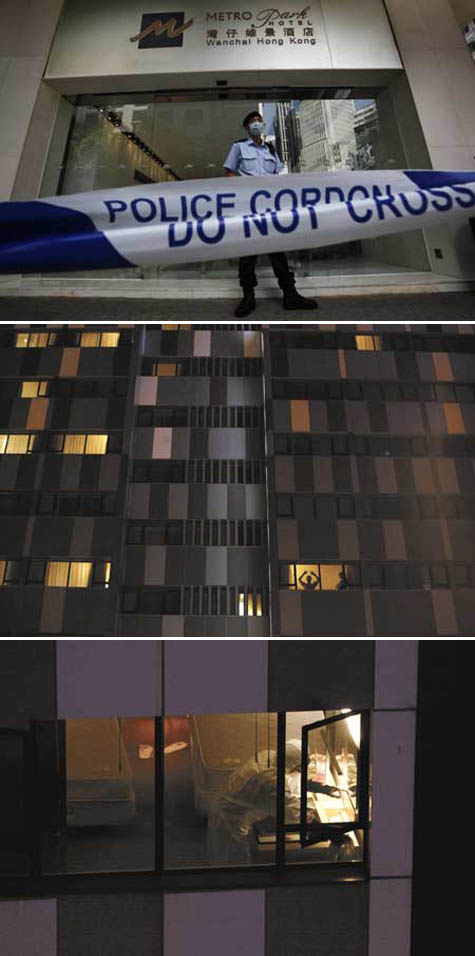 [Images: Hong Kong's entire Metro Park Hotel was put under quarantine for seven days after an H1N1-positive Mexican tourist stayed there in May 2009; "psychologists were on standby," we read. All photos courtesy of the China Post].BLDGBLOG [Images: Hong Kong's entire Metro Park Hotel was put under quarantine for seven days after an H1N1-positive Mexican tourist stayed there in May 2009; "psychologists were on standby," we read. All photos courtesy of the China Post].BLDGBLOG: In terms of these public health laws, where can quarantine occur? It was interesting during the SARS outbreak in Toronto, for instance, to see that hotel rooms were simply repurposed as temporary quarantine facilities. Dr. Benjamin: Quarantine can occur anywhere—that’s the short answer. Remember that quarantine is basically telling someone who has been exposed to a disease, even if they haven’t come down with that disease, to stay away from others, and to stay somewhere that we can observe them and see if they get sick. Functionally, that can occur anywhere—as long as you have the support that you need, and as long as you’re not kept somewhere where other people will be at risk. For someone who’s quarantined, a hospital is probably not a good place for them, because there are sick people in that hospital and, in any case, the hospital will usually need those beds. Let’s say I travel to England for a business meeting, and there’s a big infectious disease outbreak. They’re not quite sure what it is, but I could theoretically have been exposed. They don’t want me to travel back home because they don’t want me on an airplane; I could expose people on that airplane. So they ask me to stay in my hotel room, and to get room service. That’s probably a perfectly reasonable request—as long as you know that, in everybody who’s had this disease, it shows up within 48-72 hours. It might be very inconvenient, but, in the interest of public health, somebody could ask me to do that. Now, there are issues around the air circulation in the hotel, and whether or not that’s appropriate—but let’s just assume that it is. From the APHA perspective, that request would be fine, particularly if you have somebody who can call and check on you a couple times a day and make sure that you’re not getting sick in the hotel room. Now let’s say this happens at a wedding party taking place at a small hotel. For all practical purposes, if everybody at that hotel had been at the wedding, it would be reasonable to ask everybody to stay at that hotel—and, actually, they wouldn’t even have to stay in their rooms. They could be out and amongst each other, as long as they were fully informed about the symptoms that you get when you start to come down with whatever this disease process is. If those symptoms start to show, those people would then self-isolate, call public health authorities, and tell them, “I’m in my room, and I’ve got a cough and a fever, and I didn’t have that yesterday.” If it turns out that this disease process is something mild, and we know you can take care of it there in the hotel room, then we’d probably just say, OK, isolate yourself in the hotel room. Before, you were able to get up and walk around the hotel—no big deal—but now you have to stay in your room. We’ll have the concierge send up your meals, and we’ll give you some Tylenol for your temperature. If it was something like H1N1—or some other viral illness that we knew is susceptible to antiviral agents—then we may very well give you antiviral agents, too. Of course, we’d also have the hotel doctor come up and see you. However, we would still ask you to stay in your room. That’s a voluntary isolation, now, within a quarantine facility, because you’ve been separated from everybody else. The people who run the hotel, on the other hand, could say that they really don’t want this sick person staying in the hotel, for whatever reason. We’d then actually ask you to come out of the hotel; we’d come pick you up; and we’d take you to someplace else where people are being held and provided with medical care. At that point, you’re in isolation. It could be a hospital; it could be another facility. It could be a hotel; it could be a home. It could be anyplace where they’ve designated that as an isolation point. Again, in most cases it would be voluntary. So it depends—these examples show that quarantine could take place anywhere, in a variety of forms. 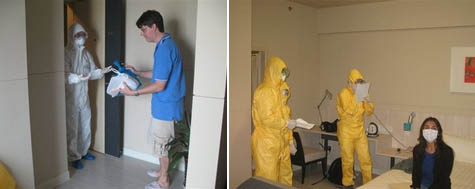 [Images: (left) Reporter Will Weissert, quarantined in China, receives his lunch sealed in a plastic bag; (right) Weissert's wife receives a medical check-up in the hotel room].BLDGBLOG [Images: (left) Reporter Will Weissert, quarantined in China, receives his lunch sealed in a plastic bag; (right) Weissert's wife receives a medical check-up in the hotel room].BLDGBLOG: Things like eminent domain and the government seizure of private property—these legal issues surely play a role in quarantine guidelines? Dr. Benjamin: You’re right—and we’ve had long discussions about those issues. For example, let’s say we have to isolate people due to a very severe disease process. In most cases, when people are sick enough, they need to, and are willing to, go to a hospital—but one of the challenges we’ve found is that hospitals don’t want to be known as the “ X-disease hospital”: the SARS hospital, the swine flu hospital, the smallpox hospital. There’s some history there—in the United States, it began with places that became known as tuberculosis sanatoriums. If the public begins to shun a place because they’re afraid of catching a disease that has somehow been associated with that hospital, then it takes that hospital out of business—even if you only have one or two cases. We saw this during the anthrax attacks at hospitals where somebody had been exposed, in whatever way, to anthrax. Even though we know anthrax is not a contagious disease, we had patients who were very concerned—at OBGYN services, in particular. Pregnant women just wouldn’t go to that hospital. As it turns out, we only had a very few cases of anthrax, but the press got onto this, and they publicized the fact that a person with anthrax had been at this particular hospital. Then that hospital had patients who were concerned about going there. So, of course, what we had to do was get on TV ourselves and say: “No, no, you don’t need to worry about that. It’s not contagious. That’s not how you get anthrax. You can still go there; you can still deliver your baby there.” But reassuring the public is sometimes very difficult. In many cases, it’s more about fear than anything else. The other piece of this is that, if you have a disease outbreak that is so widespread that you have lots of sick people, then it’s unlikely that you’ll have only one hospital impacted. One of the fallacies of people worrying about their hospital being the SARS hospital, or their hospital being the smallpox hospital, or the flu hospital, is that, in most cases, those diseases are so infectious that lots of cases are already in the hospital environment. They’re in the ER, in the outpatient clinics, etc. One hospital might have an intensive care unit, and the very sick patients may end up in that unit—but the other hospitals in the area will end up taking care of the outpatients. The likelihood of only one hospital being the hospital with a particular disease process, and being stigmatized because of that, is very low. There are exceptions, of course: let’s say you’ve got a research hospital and it has a novel therapy, and the only way to get that novel therapy is by going there—well, that hospital is going to end up with a disproportionate number of those patients. That’s one of the communication issues that hospital is going to have to manage with the public. Now, to your question, many of the public health laws do have statutes that allow for the taking of stuff. In Maryland, for example, the state can confiscate your facility—and it’s not just your facility: it could be your pharmaceuticals; it could be your box of syringes. If the state declares an emergency, and it has the authority of the law and it goes through the proper procedures, then, yes, it can confiscate things. But what we did in Maryland was we clarified a few things: firstly, that you would be compensated. We thought that was very important to put in. We also wanted to make sure that it requires extraordinary efforts to make it happen. In Maryland, for instance, a disaster has to be declared by the governor, and there’s a legal process that one has to go through in order to confiscate someone’s stuff. A lot of the plans in the U.S. for where we’ll put sick people raise some interesting issues. For example, some of these plans say that if we need to expand bed-space beyond the hospitals, then we need to use schools, gymnasiums—anyplace where you have a wide-open ward. Of course, there’s a big debate going on about whether those are the best places for these folks—and the reason for that debate is that they’re not built as health facilities. You couldn’t put your sickest people there. You might be able to quarantine people there—people who are well enough to get up and wash their hands and go to the bathroom, etc.—and you might be able to put people there who are moderately ill, but you couldn’t put very sick people there. It’s simply not set up as an intensive care unit. The other thing to remember is that, even though you’ve got a disease outbreak going through your community, you still have the other, baseline disease processes. There are still heart attacks and strokes and people with seizures and kids with fever unrelated to the flu or unrelated to the infectious disease going on. You still need beds for people at ICUs for heart attacks, and you still have to treat cancer. The management challenge is to make sure that local providers don’t set up a process, of either isolation or quarantine, that deprives them of the resources they need to maintain their ongoing health system. Edible Geography: Where are the gaps, as you see it, in public preparations for quarantine? Dr. Benjamin: There are a couple of things I can think of right away. There’s the public education aspect that we and our colleagues are continuing to work on—there’s always more that could be done there. The other thing is that we need buildings and facilities that have multiple uses. When you build hospital emergency rooms, for example—and it’s been fascinating watching this shift occur—we’ve gone from a situation where people had individual rooms in the ER to open-bed concepts. But what you need is flexibility. You need facilities flexible enough to accommodate multiple purposes. You remember I talked about a gym being utilized as a potential quarantine spot? Well, some of the issues that get in the way of that are that there are not enough electrical outlets. You can’t bring up walls to partition the place in a way that easily allows you to isolate one group and quarantine another. There also isn’t the plumbing, and there probably aren’t enough bathrooms. You’ve put a lot of people together who may have a disease—and now you have a problem, because not everybody can wash their hands. We’re all using hand sanitizers today, and they’re wonderful, and they work; but, frankly, good old soap and hot water is the best thing to use. Then again, most elementary schools were designed for little people, and now you’re about to put a bunch of adults in there; they might not have as many soap dispensers as you need, or the bathrooms are too large, or the toilets are too low, or there aren’t enough sinks. Or, again, maybe the sinks aren’t in the right place: they’re not by the bedside where infection-control needs to occur. Building an environment that thinks about these other potential uses is extremely important, for places like hotels or gyms or the other big spaces that might be used to hold a bunch of people. And, by the way, quarantine is only one need for those things: as part of our overall public health preparedness, we have to look at putting people up because of a hurricane, or floods, or a tornado, or a big infectious outbreak. The single-center principle means that a place needs to be flexible enough for large numbers of people, and in which you can have adequate infection-control, adequate toilet facilities, and adequate food facilities so that everyone can eat. If we build places that do those kinds of things, then they’ll meet all the needs for isolation, all the needs for quarantine, and all the needs for housing people in an emergency.  [Images: Shuhei Endo's "tennis dome/emergency center" (left), photographed by Kenichi Amano, next to the New Orleans Superdome, post-Katrina].BLDGBLOG [Images: Shuhei Endo's "tennis dome/emergency center" (left), photographed by Kenichi Amano, next to the New Orleans Superdome, post-Katrina].BLDGBLOG: That actually reminds me of some stadiums in Japan that were built both as sports stadiums and as earthquake-disaster centers. There’s food and water stockpiled in the basement, the entryways are sized for emergency vehicles, and so on. How would you recommend this sort of architectural adaptation, on a policy level? Dr. Benjamin: We wouldn’t have much trouble convincing the presidents of universities today, who are already challenged with a disease process big enough to affect the whole student body. In the United States right now, with H1N1, the number of sick kids is big enough that they’re having to manage those kids on campus. For a disease process in which people are going to be sick for five or seven days, it’s unrealistic to send them home once they’ve shown up on campus. Colleges are having to deal with accommodating them right now. You can bet that, at least on college campuses in the United States, they would be very sensitive to this idea of dual-use facilities, because there’s an operational need for it. The second thing is, if I was trying to do this, I would be working directly with architects and engineers, convincing them of the need to do it and then letting them sell it. They can say how best to do this, in a way that does not obstruct the primary purpose of the facility. We don’t want to interrupt anyone’s football games, but at the moment, everyone says, yes, we can put people here but it’s only going to happen once or twice in my lifetime, when the truth is that, if you design it that way, then you could use it much more frequently for that purpose. You could get dual-use out of it. Getting the people who design these places to tell us how to do it, in an appropriate and cost-efficient manner, and then having them make the case to the owners and users, so that they know that this is value added to their facility: that’s how I would get this message across. Then I would talk to elected city and state officials about ways they could leverage tax-payer dollars to get these dual-use facilities built. Let’s say I’m in city government and I have someone coming up to me wanting the city to put up tax-payer dollars to support the building of a football stadium or a basketball stadium or a new school. If I get this additional bonus—this dual-use that helps my emergency-preparedness—I’m more likely to want to use taxpayer dollars to support it. Increasingly, as you know, private sector guys are coming to the government and asking for fiscal support to build these facilities. If tax-payers are going to be paying for things, then the city or the community needs to get something out of it. I can tell you that a lot of work had to be done to fix and clean the New Orleans Superdome—but if you had built it so that it could be much more functional in an emergency situation then you would have had less damage. And from an image perspective, a dual-use sports facility now has much more of a public value. That’s my personal view, not the Association’s view; but I think it’s an effective argument. • • •This autumn in New York City, Edible Geography and BLDGBLOG have teamed up to lead an 8-week design studio focusing on the spatial implications of quarantine; you can read more about it here. For our studio participants, we have been assembling a coursepack full of original content and interviews—but we decided that we should make this material available to everyone so that even those people who are not in New York City, and not enrolled in the quarantine studio, can follow along, offer commentary, and even be inspired to pursue projects of their own. For other interviews in our quarantine series, check out Extraordinary Engineering Controls: An Interview with Jonathan Richmond, On the Other Side of Arrival: An Interview with David Barnes, The Last Town on Earth: An Interview with Thomas Mullen, and Biology at the Border: An Interview with Alison Bashford. More interviews are forthcoming.
For the past four weeks, an orange robotic arm has been constructing a brick wall in south Manhattan. 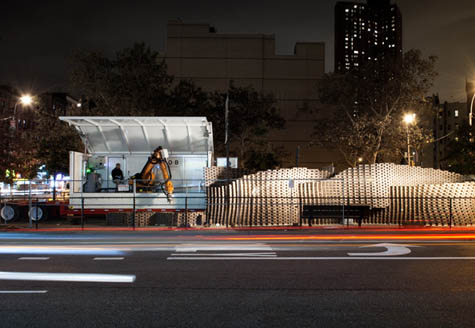 [Image: Pike Loop by Gramazio & Kohler]. [Image: Pike Loop by Gramazio & Kohler].Neither a new Berlin Wall nor part of a delayed realization of Superstudio's Continuous Monument, the machine was, in fact, built and programmed by Swiss architects Gramazio & Kohler. It is now the focus of an exhibition, called Pike Loop, at Storefront for Art and Architecture. Tonight—Tuesday, October 27—at 7pm, Storefront will be hosting a public event in celebration of the project, down at the wall itself, free and open to the public. Here's how to get there from Storefront. Be sure to stop by.
Even knowing how much it annoys certain people whenever I mention The BLDGBLOG Book on this website, I'm ridiculously excited—and admittedly quite stunned—to see that the book is #92 on Amazon.com's list of the 100 Best Books of 2009.  [Image: Six of Amazon.com's 100 Best Books of 2009]. [Image: Six of Amazon.com's 100 Best Books of 2009].To be on a list that includes J.G. Ballard, Thomas Pynchon, Nicholson Baker, A.S. Byatt, William T. Vollmann, and many more is just totally astonishing to me. But it's a fantastic testament to the strength of the architects, photographers, writers, illustrators, historians, artists, cartographers, musicians, geologists, and more whose work appears in the book, as well as to the book's designers, MacFadden & Thorpe. So thanks, Amazon! In fact, there have been many fantastic books published this year, all worth checking out if you get a chance, including China Miéville's The City & The City, David Gissen's Subnature: Architecture's Other Environments, Owen Hatherley's Militant Modernism, Leslie Chang's Factory Girls, James Lawrence Powell's Dead Pool: Lake Powell, Global Warming, and the Future of Water in the West, Tom Zoellner's Uranium, Stephen Asma's On Monsters, the paperback reissue of Infrastructural City, Greg Grandin's Fordlandia: The Rise and Fall of Henry Ford's Forgotten Jungle City, and a million more. (Thanks to Lauren Gilbert for pointing out the list!)
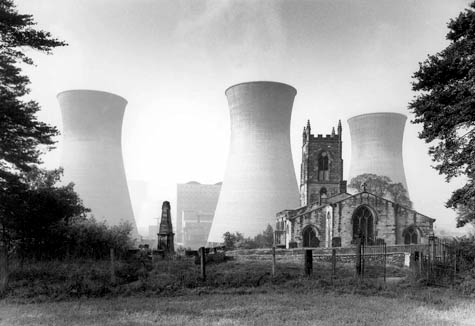 [Image: The cooling towers of the Ferrybridge power station; photo by Eric de Mare]. [Image: The cooling towers of the Ferrybridge power station; photo by Eric de Mare].The above photo has really stuck with me since seeing it last week over at Millennium People—not only its juxtaposition of architectural types (the narrative ornamentalism of a small English church almost literally overshadowed by the minimalist hyper-functionalism of the cooling towers) but the photo's implied collision of material activities (prayer, say, vs. the illuminative processing of rare fuels). I might even suggest that it presents us with some strange, nuclear-Anglican revision of what Manfredo Tafuri would call the sphere and the labyrinth—that is, the altarpiece meets the reactor core—but the station is actually coal-powered, not nuclear at all. The image is nonetheless quite stimulating. Imagine disused cooling towers repurposed as a church—or a library—or Chartres Cathedral put to work as a nuclear power station, its filigrees of saints and masonry trembling as atoms split and machines spin wildly in the basement.
There are as many as sixteen 2-billion-year old nuclear reactors in the rocks beneath Gabon. Considering their age, they are also, unsurprisingly, completely natural. 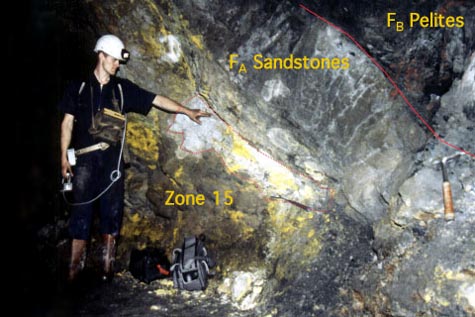 [Image: The natural clocks and ticking stratigraphy of the Oklo uranium deposit, courtesy of the Curtin University of Technology]. [Image: The natural clocks and ticking stratigraphy of the Oklo uranium deposit, courtesy of the Curtin University of Technology]."In 1972," the Curtin University of Technology explains, "the very well preserved remains of several ancient natural nuclear reactors were discovered in the middle of the Oklo Uranium ore deposit." The university adds that each of these equatorial African reactors "operated on an intermittent basis for a period ranging from a few years to hundreds of thousands of years. The total time period over which the reactors operated is thought to be about a million years." In one specific case, we read in a report published five years ago by Physical Review Focus, a chain reaction in the uranium-rich rocks "cycled on and off every three hours." The idea that radioactive deposits beneath the Earth could self-react and undergo fission was first proposed by physicist Paul Kazuo Kuroda. The internal clock of a geological formation, Kuroda suggested, given contact with water, could simply start ticking away: In 1956, nuclear chemist Paul Kazuo Kuroda of the University of Arkansas in Fayetteville predicted that a chain reaction could develop in natural uranium deposits, generating heat just as the reactor in a nuclear power plant does. His suggestion proved prophetic when, in the 1970s, others discovered several burned-out natural reactors in the Oklo uranium mines in Gabon. Amazingly, "researchers still don't know precisely how the fossil reactors managed to burn slowly for more than 150,000 years, when they could have exploded violently." The presence of underground water seems especially fortuitous in that regard—it helped to avoid a nuclear detonation. That's plausible because the water molecules would collide with neutrons whizzing through the uranium and slow them down, a process called moderation. Because slower neutrons more efficiently split the uranium nuclei in a chain reaction, the water would promote the reaction and cause the reactor to heat up. Eventually, however, the heat would boil away the water, shutting the reaction down until more water could collect. It was a pulsing rhythm, a geologic throb: based on present-day chemical measurements taken of specific isotopes in the nearby rocks, "the researchers estimate that the reactor ran for 30 minutes and then shut down for two and a half hours." 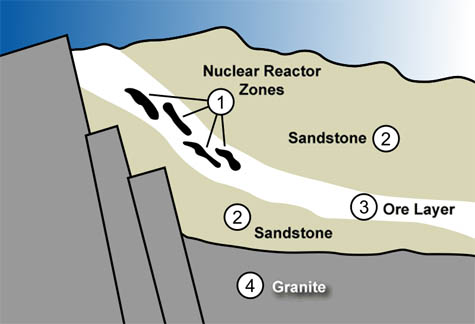 [Image: A diagram of the Oklo uranium deposit, courtesy of the U.S. Department of Energy]. [Image: A diagram of the Oklo uranium deposit, courtesy of the U.S. Department of Energy].I'm reminded again here of William Burroughs's extraordinary and haunting suggestion, from his novel The Ticket That Exploded, that, beneath the surface of the earth, there is "a vast mineral consciousness near absolute zero thinking in slow formations of crystal." Here, though, it is a mineral seam, or ribbon of heavy metal—a riff of uranium—that stirs itself awake in a regularized cycle of radiative insomnia that disguises itself as a planet. Brainrock. Gabon's " natural nuclear fission reactors," according to Wikipedia, "are the only known sites in which natural nuclear reactors existed. Other rich uranium ore bodies would also have had sufficient uranium to support nuclear reactions at that time, but the combination of uranium, water and physical conditions needed to support the chain reaction was unique to the Oklo ore bodies." Of course, this process created what we would now call nuclear waste—including plutonium. These otherwise extraordinarily dangerous waste products, however, have been entombed within the earth for two billion years. The Curtin University of Technology points out that "this is so long that all of the radioactive waste products (even those with million year half lives) have decayed away." They have also hardly even moved: the plutonium, according to the U.S. Department of Energy, "has moved less than 10 feet from where it was formed almost two billion years ago." Are there thus structural lessons to be learned from the rocks at Oklo? "By analyzing the remnants of these ancient nuclear reactors and understanding how underground rock formations contained the waste, scientists studying Oklo can apply their findings to containing nuclear waste today," the DOE goes on to suggest. This is another way of saying that the Oklo uranium deposits are being studied as natural analogues for how high-level nuclear waste might behave in an artificial repository like Yucca Mountain (watch for a long and fascinating interview with a geophysicist from Yucca Mountain here on BLDGBLOG next week). We might say, then, that a geological formation, like some nuclear version of Spanish architect Vicente Guallart's notion of geologics, has partially inspired an architectural form. The timescales are all wrong for this, meanwhile, but if geomythology is the study of ancient folk tales, oral traditions, and regional myths to see if they contain camouflaged references to real, but prehistoric, geological events—earthquakes, tsunamis, volcanic eruptions, and more—what geomythological influence might the throbbing and automechanized Oklo uranium mines play? How extraordinarily interesting would it be to come across a series of old myths about an intelligent presence in the rocks of equatorial Africa, a kind of mineralized Mother Nature winking at everyone from below—and to realize that they're referring to the reactions at Oklo. A spirit in the Earth. Finally, do these naturally occurring reactions come with the implication that our present-day nuclear reactors are, in a sense, simulated geological processes, not unlike artificial diamond-creation chambers? Nuclear reactors become models of already existing natural events. They are terrestrial reenactments, you might say. Scientific American has a five-page article about the Oklo phenomenon, if you'd like to read more.
 [Image: Photo by Richard Mosse, from Time magazine]. [Image: Photo by Richard Mosse, from Time magazine].Photographer Richard Mosse, who BLDGBLOG has interviewed in the past and who is one of many participants in this autumn's " Landscapes of Quarantine" design studio, has just published a new series of photographs in Time magazine documenting the flow of goods into and out of the Gaza Strip. This economic flow is literally underground, however, as it passes beneath the supervision of both Israel and Egypt, through a network of often quite sophisticated tunnels; channeled under pressure through tiny pores, it exhibits a surprisingly low viscosity, we might say. "The tunnels vary in size and scale," journalist Abigail Hauslohner explains in the accompanying article. "Some are fragile dirt shafts; others feature wide, wood-reinforced passageways." There are, according to the users and builders of these spaces, "hundreds of tunnels—some weaving right over one another at different depths—that are mostly used to import commercial goods that range from food and baby formula to computers and even cars." Livestock is frequently herded across the border, through electrically lit tunnels, sometimes uphill. "Centered around the town of Rafah," Hauslohner explains, these tunnels "are virtually the only way that goods have reached the residents of the tiny territory since 2002, when Hamas took control of it and Israel imposed a blockade on the its land and sea borders." 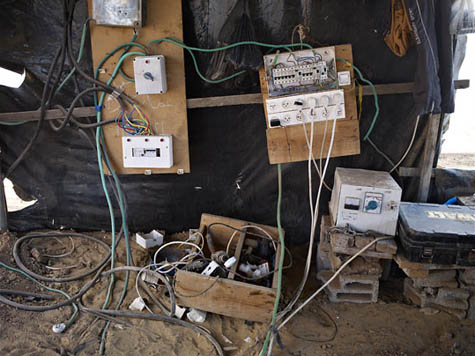 [Image: Flexible infrastructure: "The tunnels' electric and phone systems are a study in improvisation," we read; photo by Richard Mosse, from Time magazine]. [Image: Flexible infrastructure: "The tunnels' electric and phone systems are a study in improvisation," we read; photo by Richard Mosse, from Time magazine].The required physical infrastructure for these constructions spills out to include "warehouses that sell the tools used to physically shape the tunnel industry: shovels, rope, pulleys and electrical cords, plus pickaxes, hammers, nuts, bolts and screws in all sizes. The industry of making the tunnels is a booming business on its own." In the following image we see "tunnel heads," where the subterranean structures breach the Earth's surface and allow exit or entry. 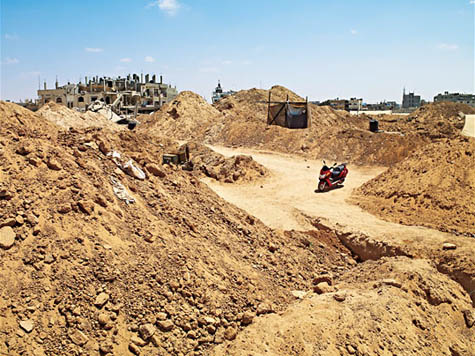 [Image: "Dirt from the digging litters the landscape," Time explains. "The smugglers say that Israel's blockade gives them no choice. Says one Rafah shopkeeper, 'Even if Israel destroys all of the tunnels entirely, I'm quite sure that the they will only be dug again and again.'" Photo by Richard Mosse, from Time magazine]. [Image: "Dirt from the digging litters the landscape," Time explains. "The smugglers say that Israel's blockade gives them no choice. Says one Rafah shopkeeper, 'Even if Israel destroys all of the tunnels entirely, I'm quite sure that the they will only be dug again and again.'" Photo by Richard Mosse, from Time magazine].Check out the rest of the photographs over at Time; but be sure to browse through Mosse's own website for some other, incredible work.
 [Image: A mobile biosafety containment apparatus in a simulated medivac exercise, via the CDC]. [Image: A mobile biosafety containment apparatus in a simulated medivac exercise, via the CDC].
Jonathan Richmond is director of Jonathan Richmond and Associates, Inc., a private biosafety consulting firm based in Atlanta, Georgia. He founded the company after nearly 35 years with the Centers for Disease Control.
The firm has a particular expertise in "facility design" for biosecure environments, with a strong emphasis on international biosafety education efforts. Richmond has worked on projects with NASA, the National Academy of Sciences, and the World Health Organization Biosafety Program, to name a few, and he has participated in supervisory visits to the remote bioweapons labs of the former Soviet Union.
As part of our ongoing series of quarantine-themed interviews, Nicola Twilley of Edible Geography and I spoke to Richmond about his firm’s work, about the technical specifics of biosafety, about the difference between biosecurity and quarantine, and about his own professional history.
• • •
BLDGBLOG: First of all, what exactly is biosafety? How is the term most commonly defined?
Jonathan Richmond: Biosafety is focused on issues related to microorganisms that cause diseases of humans or animals—and, if not the microorganisms themselves, the toxins that those organisms might produce. Achieving biosafety relies on a combination of the facility in which you’re going to work—that is, the engineering controls; the personal protective equipment that you’re able to wear; the medical surveillance programs that you’re involved with; whether you can be immunized against the disease agent, and so on—and then the practices and the procedures that you follow while you’re doing the work. The latter, ultimately, is perhaps the most important and most critical thing.
BLDGBLOG: Can you explain the difference between quarantine and biosafety?
Richmond: Quarantine is typically defined, or set up, when you have somebody who is already ill and you want to keep them from spreading their disease to other people. Our containment recommendations usually involve a range of biosafety practices, including quarantine. Some examples of that, of course, are all of the plans right now for the H1N1 swine flu. If you look at any of the websites that are talking about the precautions or procedures in college settings, for example, one of the things they emphasize is hand-washing—which is a practice or procedure that you can do to prevent the spread of a bug—but most go on to suggest that, if you are ill, then you should stay in your room. That’s a form of self-imposed quarantine. We saw quarantine go into effect on a very large scale with the SARS virus outbreaks, primarily in SE Asia and Canada: there was an absolute need to isolate the people so that they did not spread the disease further.
Edible Geography: There seem to be different levels of biosafety. Someone staying in their dorm room is not biosecure, for instance; it’s just a form of social isolation. Richmond: Yes, but that’s typically what one would do: keep the person isolated, either at home or, in the case of SARS, in hotel rooms, because they didn’t have appropriate isolation units in the hospitals. It depends, I suppose, on the extent of a disease outbreak: how many people are actually infected? In a normal hospital setting, if you have only a single case, that person would be set up in what’s called an isolation area or isolation room. But as you get overwhelmed with cases, public health takes on other aspects, including trying to keep people quarantined in their own homes. This was the standard set-up back at the turn of the last century. People would get various diseases going through the community, and public health people would go around and put a quarantine sign on your house. You were unable to have visitors; you weren’t supposed to go out. That’s basically the way things were contained.
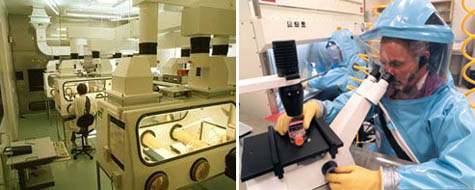 [Images: Biosafe labs and research facilities].BLDGBLOG [Images: Biosafe labs and research facilities].BLDGBLOG: Beyond these social and behavioral safeguards, what about the actual design of biosafe spaces? Richmond: We look at four different levels of biocontainment. Level one is basically no containment. Level one is for working with microorganisms that aren’t known to cause human illness. This is the kind of laboratory that, for example, you might see in a high school, or in an introductory course at the college level—even a lab that’s doing E. coli studies at your local sewer plant. It’s not much of anything at all, except simple behavioral guidelines—like don’t stick things in your mouth! Level two is for working with microorganisms that are generally circulating in the community. Those are things that may cause illness; they’re probably the childhood diseases that everyone experienced early on, or that you’ve already been vaccinated against. In these particular laboratories, there’s a lot of emphasis on such things as hand-washing, wearing gowns, and wearing gloves. The facility itself is relatively simple; it’s more like a hospital laboratory. In the scope of things, this is where 90% or more of microbiological work is done. These labs are throughout the country and around the world. With level three laboratories you begin to see some extraordinary engineering controls. These laboratories are the ones that are designed to work with microorganisms spread by the aerosol route. Level two are for ones that are spread by contact. At level three, you would see the engineering controls that give you things like directional-inward airflow. You would be looking for special filtration on exhaust air that’s leaving the labs. People would work inside biological safety cabinets, which are designed to protect the worker, to protect the product that you’re working on, and, indeed, to protect the environment – the micro-environment of the lab or the external environment. Those are really quite sophisticated in their design and in their operation. There is where a lot of work on, for instance, tuberculosis takes place in this country. A fair number of the organisms that are being considered as potential agents for bioterrorism are worked with at level three. Then the level four laboratories are super-containment labs. They’re called maximum containment labs. These are labs where people would ordinarily wear a positive pressure suit while working—so they would have air supplied to them. The diseases they’re working with are the ones for which we really don’t have any vaccines and that, for the most part, we really don’t have any method to cure you if you get ill. These are the really dangerous pathogens—things like Ebola viruses, Marburg viruses, smallpox, etc.. At level four, you have bladder gaskets around the doors and you take chemical showers when you come out so that your suit gets decontaminated—and then you take that off, and you take a regular shower (which you generally would do at level three, also). A lot of attention is also paid to the liquids at level three and four—collecting these and decontaminating them, either through chemical means or through heat treatment. Anything that comes out of a level three or four lab has to be decontaminated. Small objects—things like the used clothing, small animal carcasses, and used laboratory equipment—would be run through steam autoclaves. That will sterilize things. But the large volumes of liquid effluent that you might get, say, from showers, would be collected in a very large tank, typically directly underneath the laboratory, and then heat treated or chemically treated with chlorine. Heat treatment means that you take it up to very high temperatures for certain designated periods of time before you can then cool it down and release it into a sanitary sewer. BLDGBLOG: I’d love to hear about two or three specific projects that you’ve worked on in the past. How did those projects foreground questions of biosafety or quarantine in an interesting or perhaps unexpected way? Richmond: I used to work at CDC, and CDC is the only place in the United States—indeed, it’s one of only two places in the world—where you can work with smallpox virus. Smallpox was eradicated back in the 1970s and, at that time, a lot of work was done to make sure that any smallpox still held in laboratories was either destroyed or sent to CDC. But the other laboratory where smallpox can be worked on is at an institute called Vector, out in Russia. It’s in Siberia. I had an opportunity to visit that particular laboratory a number of years ago, to see how our Russian colleagues had their containment system set up. This was so we would could compare it to how we have things set up in the U.S. I was one of the very few Americans who were ever allowed inside that containment facility; it was an honor to go there and it was extraordinarily interesting.   [Images: From artist Luke Jerram's extraordinary Glass Microbiology project].Edible Geography [Images: From artist Luke Jerram's extraordinary Glass Microbiology project].Edible Geography: What differences did you notice in their set-up? Richmond: The Vector labs, like so many things in Russia, are built on a much larger scale than in the U.S. Buildings seem to be bigger there, and the general way they do things—things are just bigger. At the time I was there—and this would have been in the mid to late 90s—the control systems for things like airflow, which is so critical in these labs, was basically handled on a laptop computer in the U.S. Over there, however, it was all controlled by this big bank of flashing lights, and they had two or three people who simply sat there all day long and watched the flashing lights, making sure that they continued flashing. Their technology was not as far advanced. Also, the suits they wore were of a slightly different design—but they accomplished the same thing. I actually thought it was a pretty good suit. I’ve also had a chance, in the past, to work with NASA, as they began to think about sending people to Mars. If you remember, back when we sent people to the Moon, there was a concern that the astronauts might bring something back from outer space. Although they built some pretty robust facilities for it, the way they handled it was not quite the way we would do it today. In fact, I had a chance to visit the NASA facility where all of the moon rocks are stored. I was able to get inside the laboratory and fiddle around with some moon rocks. But the work for the future was looking at new issues. It started with a straightforward question: what happens if we bring samples back from Mars? In that case, there was a dual concern. On the one hand, if the samples that came back happened to have an infectious agent in them, then we wanted to make sure we could protect the workers—and that’s pretty much the same way you would protect the workers in a level four facility. But the other thing that NASA wanted to be very sure of was that we did not contaminate the samples with normal earth microorganisms. Because then you could say: oh, look, we found life on Mars! When, in reality, it was something that had been introduced once the sample got back. So we got to talk about design concepts where you would have the same biosafety technology that we have here, such as negative air pressure, to prevent any organisms from escaping the facility. On the other hand, we would normally use positive air pressure to keep bugs out of a system, say, in a facility where you’re developing of vaccines or drugs. So we had to come up with a dual system that would allow for both positive and negative air pressure at the same time.  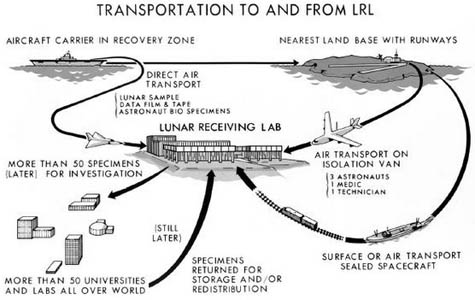 [Image: The returning Apollo astronauts relax inside their Airstream trailer/quarantine station, and their highly regulated route back from the moon].Edible Geography [Image: The returning Apollo astronauts relax inside their Airstream trailer/quarantine station, and their highly regulated route back from the moon].Edible Geography: How did you manage that? Richmond: The concept designs that we developed used cabinets. Biological safety cabinets come in three basic formats: class one, two, and three. The class three cabinets are hermetically sealed devices; your arms go into the cabinet in these big gloves that are sealed to the cabinet itself. What the designers came up with was that, since the cabinet is normally operated under negative pressure, they put a second layer around the cabinet, and that would be under positive air pressure. You could do it other ways, obviously, but that was the one we came up with. This design challenge then got extended by a project that we worked on through the National Academy of Sciences. They were thinking ahead to the point where the question became: How would we protect the astronauts if they went to Mars? How could we set up a laboratory there? That was very interesting, to learn about the geology and the geography of Mars, and to learn about some of the issues that we would have to deal with there. For example, one of the biggest problems is the dust that just covers the surface of Mars. Regolith, they call it. If you’re running any kind of air-filtration system, it would very quickly clog if you had a dust storm going on. Finally, I also had the opportunity to build a level three biocontainment laboratory in Africa—and that posed some very interesting questions. For the most part, in these developing countries, you don’t have all the things that we might expect to have, like running water or a reliable source of electricity. So the question there was: How do you design around those limitations? Edible Geography: When you were working with NASA and the National Academy of Sciences, did concerns with quarantine also run the other way—in other words, quarantining materials from earth that we send to Mars, so as not to contaminate Mars? Richmond: Yes. In fact, there’s a very interesting position in NASA; it’s called the Planetary Protection Officer. The person I met at the time who was Planetary Protection Officer was probably a combination of an engineer and a biologist—I don’t know what specific background he had. But that person oversees, and provides certain controls on, what is sent out from earth and what is returned to earth. There are different criteria for this. For example, if a rocket is just going to go out, and there’s no intent for it to land anywhere—if it’s just going to send back information—then there’s less concern for what’s called “ forward contamination.” But if we were to land that rocket on Mars, on an asteroid, or anywhere else, then there are things that we need to set up in order to sterilize a spacecraft before it can go. Then, if it comes back, there are even more concerns. We spent a lot of time talking about how we could bring a rocket back from Mars. For instance, could it land on earth? Would they have to eject a capsule and parachute it down into the desert somewhere? How exactly could we do this? There was a lot of thought given to that. The whole issue of quarantining samples, and bringing them back, also came up when the European Space Program wanted very much to be part of any Mars sample-return mission. In that case, if we can safely transport a sample from a containment lab somewhere in the U.S. to another lab in Europe, then could we also transport a subset of that sample to another country—say, to England—so that they could work on it over there? We actually have developed some very robust mechanisms for the transport of infectious materials, globally, so I think the application of those same kinds of technologies to NASA sample-return missions would help assure us that we aren’t contaminating something that we’re shipping—or it wouldn’t break open and contaminate the world. The Andromeda Strain, you know. BLDGBLOG: Is there a regulatory body that determines international standards of astronomical quarantine? For instance, what if China were to bring back a sample from Mars, but scientists in the U.S. thought it should be quarantined? How would this be regulated or enforced? Richmond: Whether there’s such an agency or not, I don’t know. But I’ve been doing a lot of work in China recently, and in southeast Asia, and they are very concerned about biocontainment. They have pretty much adopted the same standards that we have in the U.S. The CDC’s book on biocontainment has actually been translated into at least seven languages, and it has pretty much become the accepted standard around the world. So I think if you started to play around with something that you were bringing back from outer space… It’s such a small community of people, and they all have the same concerns. I am not terribly worried about the possibility of disagreement there. 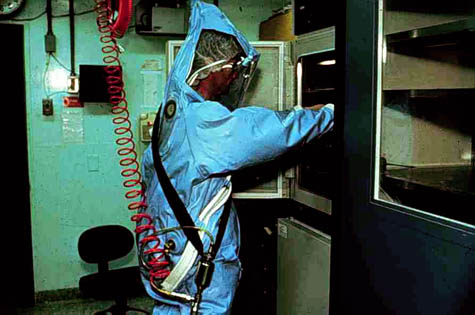 [Image: Biosafety cabinet and suited worker].BLDGBLOG [Image: Biosafety cabinet and suited worker].BLDGBLOG: I’m very interested in your own career trajectory, and in the nature of the private company that you’ve founded. Could you talk about the market niche—private biosafety consulting—that you stepped into with this? Richmond: It was a pretty logical next step, when I left CDC after about 35 years of biosafety work, because I just have a wealth of knowledge and I didn’t want to let it all disappear. I’ve done a lot of publishing, and I’ve got a lot of stuff out there; but there’s a lot more to it that just comes from experience. So we set up a very small company just to provide these services—either working with architects and engineers in the design phase, or even in the commissioning phases, or auditing the labs once their built, to make sure that they’re actually functioning the way they were intended. We also do a lot of teaching for the people who work in the labs, and for the people who support the labs, to make sure that they understand how to work safely. It’s been very interesting to be out and about. When I was at CDC, I also had lots of international travel experience. That means I’ve been able to work with ministers of health in different countries, or to work with them through different agencies. Shortly after I retired, I spent three months at the World Health Organization working with them on developing their biosafety program. I was there about two weeks—maybe three weeks—when they said, listen, we have a SARS laboratory-acquired infection in China. We want you to go and investigate it. That was really neat, to be on the ground, doing that kind of work. Edible Geography: So in that case, you were investigating a biosafety failure? Richmond: Yes—we were looking to understand how it occurred. Was there one thing—or two things, or six things, or a convergence of things—that allowed for this to happen? That’s actually something that we often do in the field. Every institution that has experienced a laboratory-acquired infection spends a lot of time trying to determine what went wrong so that we can spread the word. Was it a failure of equipment? Was it a failure of procedure? What exactly happened? This, incidentally, is the model that was established by Arnold Wedum, who is considered to be the father of biosafety. Back in the 1940s, Wedum was a physician at Fort Detrick, Maryland; at that time they were studying offensive biological warfare. He had a small team of people and, any time something went wrong, they would spend a lot of time trying to figure out what happened. What was it that allowed for an agent to escape from the tube or from the centrifuge? That work continues today, following the same guidance document, in order to figure out what’s going on. Edible Geography: How did you first get started in this field? Richmond: Years and years ago, when I first started, I was at a place called the Plum Island Animal Disease Center. That’s located just off the tip of Long Island. We did a lot of what if? scenarios there—not just about Plum Island itself. For example, we were once talking about foot-and-mouth virus: how do you contain it? And how do you eradicate it? It was an incident like that that got me out of the lab as a full-time virology researcher and into the field of biological safety. We had a breach of the containment at Plum Island back in the 1970s, and the director came to me and he said, “Richmond, we need a biosafety officer—would you like to be that?” And I said, “What’s that?” [ laughs] Because the term biosafety officer really had not been coined until 1976 or thereabouts, at the Asilomar Conference in California, where the first recombinant DNA research was presented as scientific fact. The scientists there got quite concerned—almost frightened, I suppose—not knowing what this research was going to be lead to. They called for a moratorium on this type of work until the director of the National Institutes of Health could assure them that it was safe. It took about a year of research at NIH before they came up with the guidance document about biosafety levels. But, in this document, it said that if you’re going to do this type of work then you need to have a biosafety officer. That’s how we got things started. 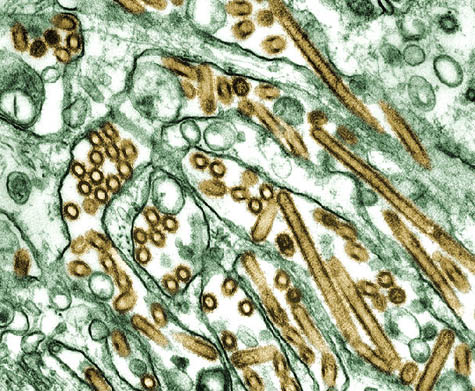 [Image: The H5N1 "bird flu" virus]. BLDGBLOG [Image: The H5N1 "bird flu" virus]. BLDGBLOG: As far as your current work goes, who, for the most part, is your clientele? In other words, are you working mostly for private firms or for state-affiliated clients? Richmond: It’s some of everything. We’ve done a lot of work in Brazil. Brazil has built a very robust biosafety program over the last dozen years. I’ve done perhaps 20% of my work in southeast Asia—a lot of work in Singapore and China. In Singapore it’s all quasi-governmental, because of the nature of their dictatorship. And in China—who knows what it is. [ laughter] But most of the work I’ve done there has been with CDC China—the equivalent of the CDC in Atlanta. I also work with private industry—companies that say, hey, we’re doing this kind of work and we need someone from the outside to come by and take a look, to make sure we’re meeting the standards. Back in 1996, a program started at CDC that, by its very nature, fell into my lap. That was to look at what has been called the " Select Agent Program," which is a bunch of microorganisms that have the potential for being used in biowarfare. Laboratories that are working with these agents have to be registered with the CDC or with the Department of Agriculture—or with both, depending upon the agent. In order to get that registration, or to keep that registration, they have to be inspected by CDC or USDA roughly once every three years. There’s a growing concern that some of these labs are not going to pass the inspection. So they contact me to do a pre-CDC inspection—we just help them to clear up the things that might stand in the way of getting, or not getting, their approval. That’s the kind of work that we do. The stuff I like to do the most, though, is teaching. Getting out there and teaching people what we call the principles of biosafety—and, how, once they’ve learned those, they can get out and start teaching them to other people in turn. To give you an example: in the mid-90s we did a program in Brazil called a “Course for Multipliers.” We had one representative from each of the seven federal laboratories, and one from each of the twenty-three state laboratories, and we gave them all a week of training. We gave them materials—Powerpoint presentations and books, all translated into Portuguese. Over the next three years, they went on to train 4,000 more people. That’s why I say that they have taken to this big time. We’ve also done training in China, and we’ve been working with Pakistani and Indian folks, first of all to get biosafety associations started there but also to do some training. The Pakistanis have since started a biosafety association; the Indians are planning to, but they haven’t actually done so yet. Edible Geography: Finally, what issues, innovations, or trends for biosafety do you see looking into the future? Richmond: That’s an interesting question. A few years ago, the United States set out to build more containment laboratories. This actually started before 9/11, as we tried to get more hospitals to have their TB work done at level three, rather than at level two. But, then, of course, after 9/11, a lot of money got pumped into the system, and there have been a whole bunch of labs built since then, both level three and level four. However, I also think we’re going to see more international growth of the field. I have a project I’ve been working on for the last five or six years now, trying to see if we can establish a standard for biosafety professionals that would be recognized globally. The World Health Organization recognizes 196 different countries, and probably only 20 of them have what you would consider a reasonable biosafety program. I think we’re going to see this gradually grow. Our concept of the world is shrinking all the time, in terms of how quickly we can move and how quickly agents can move around. And these little bugs don’t carry passports and they don’t honor borders, and we have to be vigilant. We have to take a look at whatever’s coming down the pike next. The avian flu and, now, the H1N1—and who knows what it will be next year. But there’s more and more international cooperation on this kind of stuff, and I think it’s wonderful. • • •This autumn in New York City, Edible Geography and BLDGBLOG have teamed up to lead an 8-week design studio focusing on the spatial implications of quarantine; you can read more about it here. For our studio participants, we have been assembling a coursepack full of original content and interviews—but we decided that we should make this material available to everyone so that even those people who are not in New York City, and not enrolled in the quarantine studio, can follow along, offer commentary, and even be inspired to pursue projects of their own. For other interviews in our quarantine series, check out Isolation or Quarantine: An Interview with Dr. Georges Benjamin, On the Other Side of Arrival: An Interview with David Barnes, The Last Town on Earth: An Interview with Thomas Mullen and Biology at the Border: An Interview with Alison Bashford. Many more interviews are forthcoming.
|
|
 [Image: "Moravian Mount" from New Local Zlín by Margaret Bursa].
[Image: "Moravian Mount" from New Local Zlín by Margaret Bursa].

 [Images: From New Local NY by Margaret Bursa].
[Images: From New Local NY by Margaret Bursa]. [Image: From New Local NY by Margaret Bursa].
[Image: From New Local NY by Margaret Bursa].
 [Images: From New Local NY by Margaret Bursa; larger version one and two].
[Images: From New Local NY by Margaret Bursa; larger version one and two].


 [Images: "House of Drink," "Greenhouse," and town plan from New Local Zlín by Margaret Bursa].
[Images: "House of Drink," "Greenhouse," and town plan from New Local Zlín by Margaret Bursa].

 [Image: From Layered Landscapes by Margaret Bursa].
[Image: From Layered Landscapes by Margaret Bursa].
 [Images: From Layered Landscapes by Margaret Bursa].
[Images: From Layered Landscapes by Margaret Bursa].
 [Images: From Brickscape by Margaret Bursa].
[Images: From Brickscape by Margaret Bursa].
 [Image: Michael Light, Bingham Pit photograph mounted and on display].
[Image: Michael Light, Bingham Pit photograph mounted and on display]. [Image: Two photos from
[Image: Two photos from  [Image: Michael Light, "Garfield Stack, Oquirrh Mountains and Ancient Beach of Great Salt Lake" (2006)].
[Image: Michael Light, "Garfield Stack, Oquirrh Mountains and Ancient Beach of Great Salt Lake" (2006)]. [Image: "Oops" by
[Image: "Oops" by  [Image: From Rem Koolhaas's unbuilt proposal for the Parc de la Villette in Paris, via
[Image: From Rem Koolhaas's unbuilt proposal for the Parc de la Villette in Paris, via  [Image: From a project by
[Image: From a project by  [Image: An emergency hospital ward in Kansas during the 1918 flu].
[Image: An emergency hospital ward in Kansas during the 1918 flu]. [Image:
[Image:  [Image: Sample covers of the
[Image: Sample covers of the  [Images: Hong Kong's entire Metro Park Hotel was put under quarantine for seven days after an H1N1-positive Mexican tourist stayed there in May 2009; "psychologists were on standby," we read. All photos courtesy of the
[Images: Hong Kong's entire Metro Park Hotel was put under quarantine for seven days after an H1N1-positive Mexican tourist stayed there in May 2009; "psychologists were on standby," we read. All photos courtesy of the  [Images: (left) Reporter
[Images: (left) Reporter  [Images: Shuhei Endo's "tennis dome/emergency center" (left), photographed by Kenichi Amano, next to the New Orleans Superdome, post-Katrina].
[Images: Shuhei Endo's "tennis dome/emergency center" (left), photographed by Kenichi Amano, next to the New Orleans Superdome, post-Katrina]. [Image:
[Image:  [Image: Six of Amazon.com's
[Image: Six of Amazon.com's  [Image: The cooling towers of the
[Image: The cooling towers of the  [Image: The natural clocks and ticking stratigraphy of the Oklo uranium deposit, courtesy of the
[Image: The natural clocks and ticking stratigraphy of the Oklo uranium deposit, courtesy of the  [Image: A diagram of the Oklo uranium deposit, courtesy of the U.S.
[Image: A diagram of the Oklo uranium deposit, courtesy of the U.S.  [Image: Photo by
[Image: Photo by  [Image: Flexible infrastructure: "The tunnels' electric and phone systems are a study in improvisation," we read; photo by
[Image: Flexible infrastructure: "The tunnels' electric and phone systems are a study in improvisation," we read; photo by  [Image: "Dirt from the digging litters the landscape," Time explains. "The smugglers say that Israel's blockade gives them no choice. Says one Rafah shopkeeper, 'Even if Israel destroys all of the tunnels entirely, I'm quite sure that the they will only be dug again and again.'" Photo by
[Image: "Dirt from the digging litters the landscape," Time explains. "The smugglers say that Israel's blockade gives them no choice. Says one Rafah shopkeeper, 'Even if Israel destroys all of the tunnels entirely, I'm quite sure that the they will only be dug again and again.'" Photo by  [Image: A mobile biosafety containment apparatus in a simulated medivac exercise, via the
[Image: A mobile biosafety containment apparatus in a simulated medivac exercise, via the  [Images: Biosafe labs and research facilities].
[Images: Biosafe labs and research facilities].
 [Images: From artist Luke Jerram's extraordinary
[Images: From artist Luke Jerram's extraordinary 
 [Image: The returning Apollo astronauts relax inside their Airstream trailer/quarantine station, and their highly regulated route back from the moon].
[Image: The returning Apollo astronauts relax inside their Airstream trailer/quarantine station, and their highly regulated route back from the moon]. [Image: Biosafety cabinet and suited worker].
[Image: Biosafety cabinet and suited worker]. [Image: The H5N1 "bird flu" virus].
[Image: The H5N1 "bird flu" virus].


